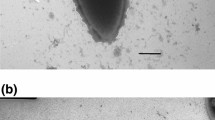Abstract
Enrichment cultures for heliobacteria at 50°C yielded several strains of a thermophilic heliobacterium species from Yellowstone hot spring microbial mats and volcanic soils from Iceland. The novel organisms grew optimally above 50°C, contained bacteriochlorophyll g, and lacked intracytoplasmic membranes. All isolates were strict anaerobes and grew best as photoheterotrophs, although chemotrophic dark growth on pyruvate was also possible. These thermophilic heliobacteria were diazotrophic and fixed N2 up to their growth temperature limit of 56°C. Phylogenetic studies showed the new isolates to be specific relatives of Heliobacterium gestii and, as has been found in H. gestii, they produce heat-resistant endospores. The unique assemblage of properties found in these thermophilic heliobacteria implicate them as a new species of this group, and we describe them herein as a new species of the genus Heliobacterium, Heliobacterium modesticaldum.
Similar content being viewed by others
References
Beer-Romero P, Gest H (1987) Heliobacillus mobilis, a peritrichously flagellated anoxyphototroph containing bacterichlorophyll g. FEMS Microbiol Lett 41:109–114
Blankenship RE (1992) Origin and early evolution of photosynthesis. Photosyn Res 33:91–111
Brock TD (1978) Thermophilic microorganisms and life at high temperature. Springer, Berlin Heidelberg New York, pp 20–27
Brockmann H Jr, Lipinski A (1983) Bacteriochlorophyll g. A new bacteriochlorophyll from Heliobacterium chlorum. Arch Microbiol 136:17–19
Castenholz RW (1988) The green sulfur and nonsulfur bacteria of hot springs. In: Olson JM, Ormerod JG, Amesz J, Stackebrandt E, Trüper HG (eds) Green photosynthetic bacteria. Plenum Press, New York, pp 243–255
Castenholz RW, Pierson BK (1995) Ecology of thermophilic anoxygenic phototrophs. In: Blankenship RE, Madigan MT, Bauer CE (eds) Anoxygenic photosynthetic bacteria. Kluwer, Dordrecht (in press)
Castenholz RW, Bauld H, Jørgensen BB (1990) Anoxygenic microbial mats of hot springs: thermophilic Chlorobium sp. FEMS Microbiol Ecol 74:325–336
Dorssen RJ van, Vasmal H, Amesz J (1985) Antenna organization and energy transfer in membranes of Heliobacterium chlorum. Biochim Biophys Acta 809:199–203
Favinger J, Stadtwald R, Gest H (1989) Rhodospirillum centenum, sp. nov., a thermotolerant cyst-forming anoxygenic photosynthetic bacterium. Antonie Van Leeuwenhoek 55:291–296
Gest H, Favinger JL (1983) Heliobacterium chlorum, an anoxygenic brownish-green photosynthetic bacterium containing a “new” form of bacteriochlorophyll. Arch Microbiol 136:11–16
Gest H, Favinger JL, Madigan MT (1985) Exploitation of N2-fixation capacity for enrichment of anoxygenic photosynthetic bacteria in ecological studies. FEMS Microbiol Ecol 31:317–322
Heda GD, Madigan MT (1986) Utilization of amino acids and lack of diazotrophy in the thermophilic anoxygenic phototroph Chloroflexus aurantiacus. J Gen Microbiol 132:2469–2473
Imhoff JF, Trüper HG (1977) Ectothiorhodospira halochloris sp. nov., a new extremely halophilic phototrophic bacterium containing bacteriochlorophyll b. Arch Microbiol 114:115–121
Kimble LK, Madigan MT (1992) Nitrogen fixation and nitrogen metabolism in heliobacteria. Arch Microbiol 158:155–161
Kimble LK, Stevenson AK, Madigan MT (1994) Chemotrophic growth of heliobacteria in darkness. FEMS Microbiol Lett 115:51–56
Madigan MT (1984) A novel photosynthetic purple bacterium isolated from a Yellowstone hot spring. Science 225:313–315
Madigan MT (1986) Chromatium tepidum, sp. nov., a thermophilic photosynthetic bacterium of the family Chromatiaceae. Int J Syst Bacteriol 36:222–227
Madigan MT (1992) The family Heliobacteriaceae. In: Balows A, Trüper HG, Dworkin M, Harder W, Schleifer K-H (eds) The prokaryotes, 2nd edn. Springer, Berlin Heidelberg New York, pp 1981–1992
Madigan MT, Gest H (1979) Growth of the photosynthetic bacterium Rhodopseudomonas capsulata chemoautotrophically in darkness with H2 as the energy source. J Bacteriol 137:524–530
Madigan MT, Ormerod JG (1995) Taxonomy, physiology and ecology of heliobacteria. In: Blankenship RE, Madigan MT, Bauer CE (eds) Anoxygenic photosynthetic bacteria. Kluwer, Dordrecht (in press)
Marmur J (1961) A procedure for the isolation of deoxyribonucleic acid from micro-organisms. J Mol Biol 3:208–218
Miller KR, Jacob JS, Smith U, Kolaczkowski S, Bowman MK (1986) Heliobacterium chlorum: cell organization and structure. Arch Microbiol 146:111–114
Ormerod J, Nesbakken T, Torgersen Y (1990) Phototrophic bacteria that form heat resistant endospores. In: Baltscheffsky M (ed) Current research in photosynthesis, vol 4. Kluwer, Dordrecht, pp 935–938
Pierson BK, Castenholz RW (1974) A phototrophic gliding filamentous bacterium of hot spring, Chloroflexus aurantiacus, gen. and sp. nov. Arch Microbiol 100:5–24
Resnick S, Madigan MT (1989) Isolation and characterization of a mildly thermophilic nonsulfur purple bacterium containing bacteriochlorophyll b. FEMS Microbiol Lett 65:165–170
Starynin DA, Gorlenko VM (1993) Sulphide oxidizing sporeforming heliobacteria isolated from a thermal sulphide spring. Microbiology English translation of Mikorbiologiia 62:99–104
Stevenson AK (1993) Isolation and characterization of heliobacteria from soils worldwide. M.A. thesis, Southern Illinois University, Carbondale, Ill, USA
Stevenson AK, Kimble LK, Madigan MT (1993) Isolation and characterization of heliobacteria from soils worldwide (abstract). American Society for Microbiology General Meeting
Wahlund TM, Madigan MT (1993) Nitrogen fixation by the thermophilic green sulfur bacterium Chlorobium tepidum. J Bacteriol 175:474–478
Wahlund TM, Woese CR, Castenholz RW, Madigan MT (1991) A thermophilic green sulfur bacterium from New Zealand hot springs, Chlorobium tepidum sp. nov. Arch Microbiol 156:81–90
Wickstrom CE (1980) Distribution and physiological determinants of blue-green algal nitrogen fixation along a thermogradient. J Phycol 16:436–443
Woese CR (1987) Bacterial evolution. Microbiol Rev 51:221–271
Woese CR, Debrunner-Vossbrinck BA, Oyaizu H, Stackebrandt E, Ludwig W (1985) Gram-positive bacteria: possible photosynthetic ancestry. Science 229:762–765
Author information
Authors and Affiliations
Corresponding author
Rights and permissions
About this article
Cite this article
Kimble, L.K., Mandelco, L., Woese, C.R. et al. Heliobacterium modesticaldum, sp. nov., a thermophilic heliobacterium of hot springs and volcanic soils. Arch. Microbiol. 163, 259–267 (1995). https://doi.org/10.1007/BF00393378
Received:
Accepted:
Issue Date:
DOI: https://doi.org/10.1007/BF00393378




